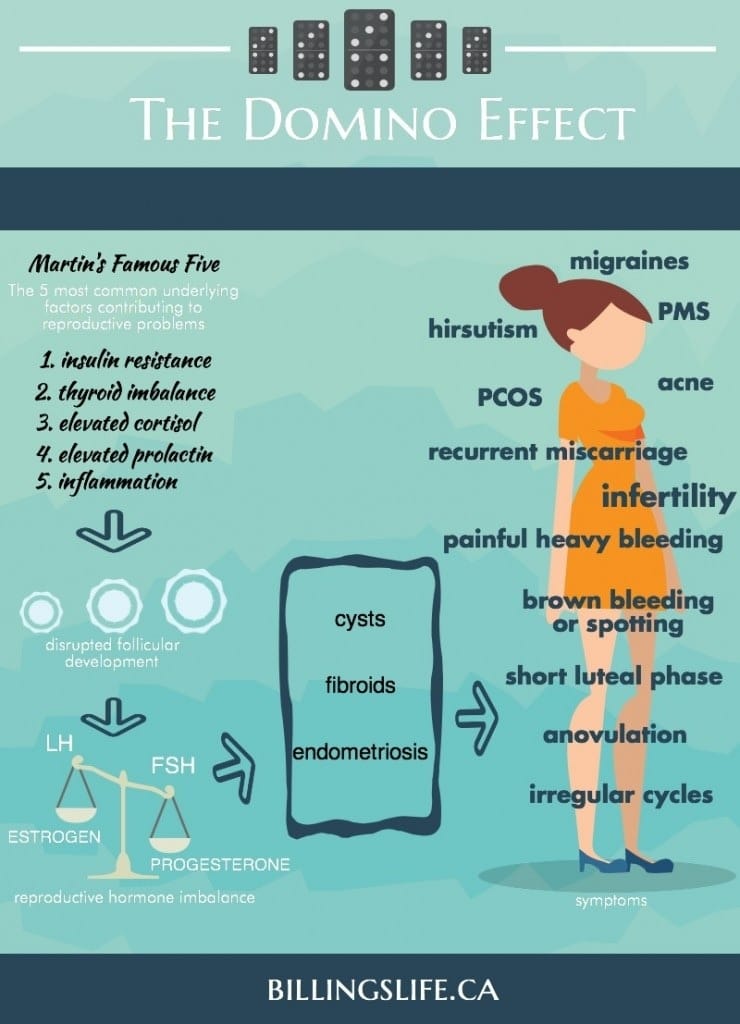Infertility and Cycle Health
Difficulty conceiving is becoming more common. Approximately 1 in 6 couples face difficulties.
Infertility and Cycle Health
Difficulty conceiving is becoming more common. Approximately 1 in 6 couples face difficulties. Advice about timing intercourse to coincide with ovulation can make all the difference! The Billings Ovulation Method® teaches couples to recognize the time of maximum fertility when conception is most likely to occur. This simple information has helped many couples conceive naturally.
Sometimes reproductive problems hinder conception. The Billings Ovulation Method® fertility chart can be used as a diagnostic tool to help identify and correct such problems, to restore and improve fertility.
Ovulatory dysfunction is the absence of ovulation or abnormal ovarian activity. This is a major cause of infertility, repeat miscarriage, and the other troubling gynecological symptoms. Women with reproductive abnormalities are often prescribed hormonal contraceptives as a way to regulate hormones and cycles. Hormonal contraceptives may alleviate some of the symptoms, but do not correct the underlying problem. Dr. Mary Martin, M.D., F.A.C.O.G outlines the five most common underlying causes of an interference with healthful ovulation, so keep reading!
Keeping a chart of your cycles and your cervical mucus patterns will help in the diagnosis of your condition and planning your treatment. And if you’re trying to conceive, your chart will help you work out which cycles might be fertile ones and which ones are not. An Accredited Billings Ovulation Method® teacher will help you make sense of your chart and support you in seeking the appropriate medical assistance for restoring hormonal health and fertility.
Bleeding that’s Heavy, Painful, or Prolonged may indicate that Fibroids or polyps may be present. Those may grow due to being hyper-estrogenic, which is the result of a continual disruption with the ovulation process. Identifying and treating the underlying cause of the disturbance helps to restore normal ovulation, which improves cycles and bleeding.
Low progesterone is a symptom of a disturbance with follicular development. By identifying and treating the root cause of the disturbance, natural progesterone levels can self correct. Supplemental progesterone can help manage symptoms, but does not correct the underlying disturbance which causes this in the first place. The underlying hormonal imbalance can continue to inhibit optimal health, even when the symptoms of low progesterone are managed. Once supplementation is discontinued, the symptoms may return if the underlying hormone imbalance still exists.
Endometriosis
This is a condition where the endometrium develops and grows outside the uterus. The fallopian tubes, ovaries, urinary organs or intestinal organs may be affected. It may occur, due to being hyper-estrogenic over a prolonged period of time, because of an interference with healthful ovulation.
About 30 to 40 percent of women with the condition may experience infertility because of scarring in their reproductive organs. Symptoms vary, but may include irregular and heavy menstruation, pain during sex, and pelvic pain for a few days before and during menstruation. By being familiar with your normal patterns of cervical mucus you are likely to detect this problem at an early stage because the pattern may not develop normally.
Polycystic Ovarian Syndrome (PCOS)
Adrenal and ovarian hormone abnormalities are the most frequent cause of ovarian dysfunction, and the most common example of this is Polycystic Ovarian Syndrome or PCOS. This condition can present with a variety of symptoms in a variety of combinations! PCOS is often connected to insulin resistance, which causes high insulin levels. Their ovaries and adrenal glands may also be producing too much testosterone. These hormonal imbalances mean that the follicle containing the developing ovum can’t mature properly. Often the ovum doesn’t get released from the ovary, so there is no ovulation. The struggling follicle keeps making more testosterone, and this interferes with the ovulatory process. It isn’t long before many of these tiny cysts cover the ovaries.
If you have PCOS, you may have had irregular cycles since you first began menstruating. Other symptoms can include acne, hirsutism, and weight gain, but some women have none of these symptoms. When keeping your chart you may notice a continuous fertile type of mucus pattern, or days of sticky or slippery mucus forming no progressive pattern to a Peak of fertility.
All of these types of conditions can point to the presence of an underlying hormonal imbalance, which may be fairly simple to treat.
Below are the five most common underlying imbalances,
as outlined by Dr. Mary Martin, M.D.,F.A.C.O.G.
Our brochure Unraveling the Mystery of PCOS
will give you more helpful information by Dr. Martin


The 5 most common underlying factors contributing to reproductive problems
1. Insulin Resistance
2. Thyroid Imbalance
3. Elevated Cortisol
4. Elevated Prolactin
5. Inflammation
Martin’s Famous 5 Descriptions
Insulin resistance causes an interference with ovulation and increases the risk of developing diabetes. Insulin and glucose levels should be measured, and medication, diet and exercise may be prescribed to treat the insulin resistance. Regulating insulin levels and restoring glucose balance can help control testosterone production as well. This will help restore normal ovulation and regular cycles.
2. Hyperprolactinemia
Prolactin is a hormone associated with breastfeeding, but sometimes high levels of this hormone develop after taking certain medications or due to conditions like a pituitary tumor or a hormone imbalance like hypothyroidism. The excess prolactin interferes with the hormones that control the growth of the follicles. Women with this hormonal disorder may not menstruate at all, have irregular bleeding or they may have short cycles with pre-menstrual spotting. Hyperprolactinemia can be treated with medication.
3. Hyperthyroidism & Hypothyroidism
Women with thyroid hormone imbalances may have irregular menstrual cycles with long gaps between menstruations, which may be heavy and prolonged or unusually light. Pre and post menstrual spotting can also be a symptom. Abnormal patterns of cervical mucus can help to identify a thyroid abnormality.
4. Inflammation
Inflammation results in inflammatory fluid which forms a slimy capsule around the ovary. This impedes and interferes with healthful ovulation. Inflammatory processes of the reproductive system are the second most frequent cause of infertility. Some examples of conditions which may produce this inflammatory response: endometriosis, food intolerances, irritable bowel syndrome, STI’s.
5. Elevated Cortisol
Cortisol is known as the stress hormone. One of the principal effects of elevated cortisol is to thwart the effect of insulin, rendering the body’s cells insulin resistant. Cortisol is made from progesterone and these compete for common receptors on the cell. High cortisol impairs progesterone, which leads to estrogen dominance. High cortisol can also lead to thyroid resistance.



